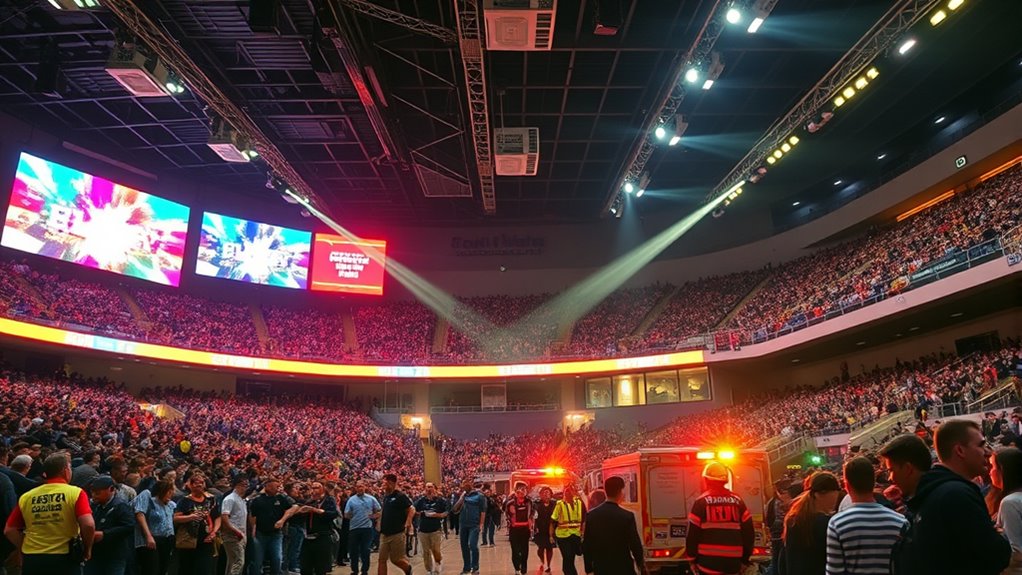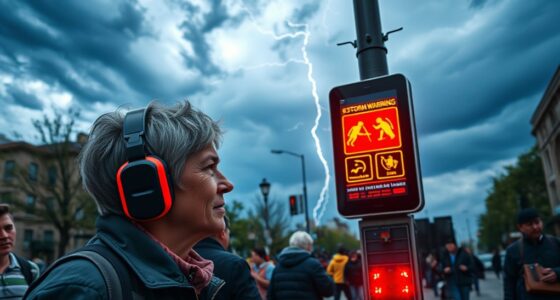Designing effective multi-modal emergency alerts for stadiums and arenas involves understanding the environment’s size, layout, and crowd behavior. You should incorporate auditory, visual, and tactile signals to reach diverse audiences, including those with disabilities. Use clear icons, high-contrast visuals, and distinct sounds, ensuring messages are quick and understandable. Regular testing and staff training enhance system reliability. Continue exploring these strategies to develop a holistic, inclusive alert system that saves lives during emergencies.
Key Takeaways
- Incorporate multiple alert channels—visual, auditory, and tactile—to ensure comprehensive communication tailored to diverse audience needs.
- Utilize high-contrast visuals, clear icons, and sound patterns for quick recognition and effective message delivery in noisy, crowded environments.
- Implement redundancies such as SMS, apps, and PA systems to guarantee alert reach despite environmental or technical disruptions.
- Regularly test, simulate emergencies, and update systems to maintain reliability and optimize response times during actual events.
- Design inclusive features like sign language interpretation and tactile alerts to support accessibility for all individuals.
Understanding the Unique Environment of Large Venues

Large venues present a complex environment for emergency communication because their size and layout can hinder the effective delivery of alerts. The way crowds behave in these spaces—often unpredictable and densely packed—can complicate message dissemination. Structural acoustics also play a critical role; thick walls, high ceilings, and varying materials can muffle sounds or distort messages, making it difficult for attendees to hear alerts clearly. As a result, relying solely on traditional audio warnings isn’t enough. You need to contemplate how crowd movement and acoustical challenges interact within the venue. Without understanding these factors, critical alerts may not reach everyone in time, increasing safety risks. Recognizing the environment’s unique characteristics is essential for designing effective multi-modal alert systems tailored to large venues.
Key Components of Multi-Modal Alert Systems

Effective multi-modal alert systems combine various communication channels to guarantee that everyone receives critical messages promptly. Key components include:
- Wireless Interoperability – Ensures alerts can reach devices across different networks seamlessly, preventing communication gaps.
- User Customization – Allows you to tailor alerts based on audience needs, increasing relevance and response rates.
- Multiple Channels – Incorporates visual, auditory, and tactile alerts, such as screens, sirens, and vibration alerts, to reach diverse audiences.
- Real-Time Delivery – Provides instant message dissemination, minimizing delay during emergencies.
- Color Accuracy and Contrast Ratio – The effectiveness of visual alerts significantly depends on color accuracy and contrast ratio, which ensure messages are clear, visible, and distinguishable even in challenging lighting conditions.
These components work together to create a reliable, adaptable system that effectively communicates across large venues, ensuring everyone stays informed and safe during crises.
Ensuring Accessibility and Inclusivity in Emergency Communications

To guarantee everyone receives critical emergency information, communication systems must prioritize accessibility and inclusivity. You should incorporate sign language interpretation in visual displays or live announcements to assist deaf or hard-of-hearing individuals. Tactile alert systems are essential for those with visual impairments, providing physical cues like vibrating devices or textured signals that alert them to danger. Ensuring these features are seamlessly integrated into your alert design helps create an inclusive environment. Clear, consistent messaging across multiple modalities ensures that no one misses vital information. Regular staff training on accessibility features also plays a crucial role. Understanding how essential oils work can inform the development of multisensory emergency alerts that accommodate diverse needs. By focusing on these elements, you make sure your emergency communications serve everyone effectively, reducing risks and fostering a safe, inclusive space for all attendees.
Integrating Technology for Rapid and Reliable Notifications

Integrating advanced technology is essential to guarantee emergency notifications are both rapid and reliable. Wireless integration ensures alerts reach everyone quickly, regardless of infrastructure limitations. To maximize effectiveness, focus on:
- Seamless wireless communication systems that connect all alert devices instantly
- Customizable alert settings to suit different audience needs and preferences
- Redundant channels like SMS, mobile apps, and PA systems for backup delivery
- Real-time monitoring tools to verify message delivery and system performance
- Incorporating disaster preparedness strategies enhances the overall effectiveness of emergency alert systems.
Designing Clear and Effective Visual Signals

Designing clear and effective visual signals is crucial for ensuring that emergency messages are quickly understood, even in stressful situations. To achieve this, prioritize strong color contrast so that signals stand out against their backgrounds, making them easily visible from a distance. Use high-contrast color combinations like white on red or yellow on black to draw attention immediately. Additionally, guarantee icon clarity by choosing simple, universally recognizable symbols that convey the message instantly. Avoid cluttered or complex graphics that can cause confusion. Consistency in icon design and color usage helps reinforce recognition during emergencies. When visual signals are clear and distinct, you reduce response times and enhance safety for everyone in the stadium or arena. Proper installation guidelines ensure that visual alert systems are correctly set up for maximum effectiveness.
Crafting Auditory Alerts for Maximum Reach

Effective auditory alerts complement visual signals by guaranteeing that emergency messages reach everyone, even when visual cues are missed or obscured. To maximize reach, focus on these strategies:
Auditory alerts ensure all stadium visitors receive emergency messages clearly and promptly.
- Use clear voice modulation to convey urgency without causing panic.
- Incorporate distinct sound patterns to differentiate alerts from background noise.
- Apply sound localization techniques so messages seem to come from specific directions, guiding people effectively.
- Adjust volume levels dynamically to ensure audibility across various stadium zones.
- Incorporate preppy dog names that evoke a sense of sophistication and style, which can be used for naming alert systems or features to make them more memorable and engaging.
Testing, Training, and Maintaining Alert Protocols

You need to regularly run simulation drills to guarantee your alert protocols work smoothly under real conditions. Conduct system performance assessments to identify and fix any issues before an emergency occurs. Consistent testing and training keep your team prepared and your alert systems reliable. Incorporating water park safety features into your training can help prepare staff for potential emergencies in large venues.
Regular Simulation Drills
Regular simulation drills are essential for guaranteeing that emergency alert protocols remain reliable and effective. They help you identify gaps in procedures, understand crowd psychology, and adapt to unpredictable situations. During drills, focus on:
- Engaging staff in realistic scenarios to observe response times.
- Evaluating how the crowd reacts to alerts and adjusting messaging accordingly.
- Reviewing legal considerations to ensure compliance and avoid liabilities.
- Updating protocols based on lessons learned to improve overall safety.
These drills reinforce training, clarify roles, and build confidence among staff and attendees. By regularly practicing, you better anticipate crowd behavior and ensure that your multi-modal alerts deliver clear, timely information, reducing panic and confusion during actual emergencies.
System Performance Assessments
To guarantee emergency alert systems perform reliably when it matters most, ongoing testing, training, and maintenance are essential. Regular system performance assessments help identify issues early, ensuring protocols work seamlessly under pressure. Incorporate redundancy planning to prevent single points of failure, so alerts reach everyone even if part of the system fails. Evaluate system scalability to confirm your setup can handle large crowd sizes and multiple alert channels simultaneously. Conduct periodic drills and simulations, adjusting protocols based on findings. Maintain hardware and software updates to stay current with technological advances. Document all assessments thoroughly, creating a clear maintenance schedule. Engaging with remote hackathons can also facilitate innovative solutions and collaborative troubleshooting for your alert systems. This ongoing process ensures your multi-modal alert system remains resilient, adaptable, and ready to deliver life-saving instructions confidently when emergencies arise.
Frequently Asked Questions
How Do Weather Conditions Affect Alert Effectiveness in Stadiums?
Weather impact can substantially influence how well emergency alerts work in stadiums. Severe rain, wind, or fog may hinder sound clarity and visibility, making alerts less effective. To guarantee your messages reach everyone, you should adapt alerts for different conditions, like using visual signals or mobile notifications. By considering weather impacts, you can improve alert adaptation and ensure all spectators receive timely, clear emergency information regardless of weather challenges.
What Privacy Concerns Arise With Multi-Modal Emergency Alerts?
When considering multi-modal emergency alerts, privacy concerns are significant. You need to guarantee data security so personal information isn’t compromised. Users might worry about how their data is collected and used, making user consent essential. Clear communication about privacy policies helps build trust. You must balance providing timely alerts with respecting individual privacy, ensuring sensitive data stays protected and users feel confident in the system’s security measures.
How Can Alerts Be Customized for Different Event Types?
You can customize alerts for different event types by using event-specific messaging tailored to the situation, ensuring clarity and relevance. Audience segmentation plays a key role, allowing you to target specific groups within the stadium based on location or interest. This way, you deliver precise, timely information, whether it’s a sports game, concert, or emergency, enhancing safety and engagement for everyone present.
What Are the Costs Associated With Implementing Multi-Modal Systems?
When considering multi-modal systems, you’ll need to account for implementation costs, which include purchasing hardware, software, and integration. Maintenance expenses also add up over time, covering updates, repairs, and staff training. These costs vary based on system complexity and stadium size. While initial investments might be high, the improved safety and communication efficiency can justify the expenses, making it a worthwhile security upgrade for your venue.
How Do Staff Coordinate During Simultaneous Multi-Channel Alerts?
During simultaneous multi-channel alerts, you guarantee staff coordinate effectively by implementing clear communication protocols and regular staff training. You assign specific roles for managing each alert channel, such as PA systems, digital signage, and mobile alerts. You also hold drills to practice coordination, so everyone knows their responsibilities. This preparation helps staff respond swiftly and cohesively, minimizing confusion and ensuring a safe, efficient emergency response.
Conclusion
By designing multi-modal emergency alerts that resonate like a guiding beacon, you guarantee safety becomes a shared promise. When every signal — visual or auditory — acts as a lighthouse, you create a sanctuary where chaos is met with clarity. Your efforts transform a stadium from a potential chaos into a fortress of trust. With thoughtful communication, you don’t just warn; you illuminate a path to safety, turning uncertainty into unwavering confidence.











